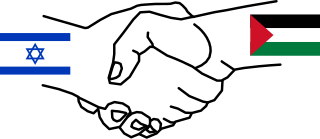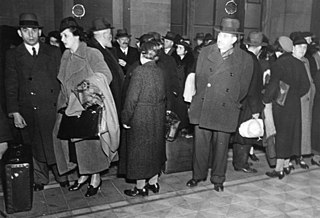
The demographics of Israel, monitored by the Israel Central Bureau of Statistics, encompass various attributes that define the nation's populace. Since its establishment in 1948, Israel has witnessed significant changes in its demographics. Formed as a homeland for the Jewish people, Israel has attracted Jewish immigrants from Europe, Asia, Africa, and the Americas.

This is a demography of the population of Kuwait.

Israelis are the citizens and nationals of the State of Israel. The country's populace is composed primarily of Jews and Arabs, who respectively account for 75 percent and 20 percent of the national figure; followed by other ethnic and religious minorities, who account for 5 percent.
The Law of Return is an Israeli law, passed on 5 July 1950, which gives Jews, people with one or more Jewish grandparent, and their spouses the right to relocate to Israel and acquire Israeli citizenship. Section 1 of the Law of Return declares that "every Jew has the right to come to this country as an oleh [immigrant]". In the Law of Return, the State of Israel gave effect to the Zionist movement's "credo" which called for the establishment of Israel as a Jewish state. In 1970, the right of entry and settlement was extended to people with at least one Jewish grandparent and a person who is married to a Jew, whether or not they are considered Jewish under Orthodox interpretations of Jewish law.

The one-state solution is a proposed approach to resolving the Israeli–Palestinian conflict, according to which one state would be established between the River Jordan and the Mediterranean. Proponents of this solution advocate a single state encompassing the currently recognized state of Israel, the West Bank and the Gaza Strip. The term one-state reality describes the belief that the current situation in Israel/Palestine is de facto a single state. The one-state solution is sometimes also called a bi-national state, owing to the hope that the state would be a homeland for both Jews and Palestinians.

The Arab citizens of Israel are the country's largest ethnic minority. They are colloquially referred to in Arabic as either 48-Arabs or 48-Palestinians, denoting the fact that they have remained in Israeli territory since the Green Line was agreed upon between Israel and the Arab countries as part of the 1949 Armistice Agreements. According to several sources, the majority of Arabs in Israel now prefer to be identified as Palestinian citizens of Israel. International media outlets often use the term "Arab-Israeli" or "Israeli-Arab" to distinguish Israel's Arab citizens from the Palestinian Arabs residing in the Israeli-occupied territories. They are formerly, or are descended from, those Arabs who belonged to the British Mandate for Palestine through Palestinian Citizenship Order 1925. Speakers of both Arabic and Hebrew, they self-identify in a wide range of intersectional civic, national, and religious identities.
In international law, a stateless person is someone who is "not considered as a national by any state under the operation of its law". Some stateless people are also refugees. However, not all refugees are stateless, and many people who are stateless have never crossed an international border. At the end of 2022, the United Nations High Commissioner for Refugees estimated 4.4 million people worldwide as either stateless or of undetermined nationality, 90,800 (+2%) more than at the end of 2021.

Isratin or Isratine, also known as the bi-national state, is a proposed unitary, federal or confederate Israeli-Palestinian state encompassing the present territory of Israel, the West Bank and the Gaza Strip. Depending on various points of view, such a scenario is presented as a desirable one-state solution to resolving the Israeli–Palestinian conflict, or as a calamity in which Israel would ostensibly lose its character as a Jewish state and the Palestinians would fail to achieve their national independence within a two-state solution. Increasingly, Isratin is being discussed not as an intentional political solution – desired or undesired – but as the probable, inevitable outcome of the continuous growth of the Jewish settlements in the West Bank and the seemingly irrevocable entrenchment of the Israeli occupation there since 1967.
An ethnocracy is a type of political structure in which the state apparatus is controlled by a dominant ethnic group to further its interests, power, dominance, and resources. Ethnocratic regimes in the modern era typically display a 'thin' democratic façade covering a more profound ethnic structure, in which ethnicity – and not citizenship – is the key to securing power and resources.

Denaturalization is the loss of citizenship against the will of the person concerned. Denaturalization is often applied to ethnic minorities and political dissidents. Denaturalization can be a penalty for actions considered criminal by the state, often only for errors in the naturalization process such as fraud. Since the 9/11 attacks, the denaturalization of people accused of terrorism has increased. Because of the right to nationality, recognized by multiple international treaties including Article 15 of the Universal Declaration of Human Rights, denaturalization is often considered a human rights violation.
Human rights in Kuwait are a topic of significant concern. Most notably, Kuwait's handling of the stateless Bedoon crisis has come under substantial criticism from international human rights organisations and the United Nations. Kuwait has the largest number of stateless people in the entire region. Kuwait also faces significant criticism for the human rights violations against foreign nationals, women, and LGBT people. Although Kuwaiti law theoretically pledges to protect all human rights; the enforcement mechanisms designed to help protect human rights are very limited in Kuwait.

The Lieberman Plan, also known in Israel as the "Populated-Area Exchange Plan", was proposed in May 2004 by Avigdor Lieberman, the leader of the Israeli political party Yisrael Beiteinu. The plan suggests an exchange of populated territories – territories populated by both Arabs and Jews – between Israel and the Palestinian Authority.

Israeli citizenship law details the conditions by which a person holds citizenship of Israel. The two primary pieces of legislation governing these requirements are the 1950 Law of Return and 1952 Citizenship Law.
The concept of demographic threat is a term used in political conversation or demography to refer to population increases from within a minority ethnic or religious group in a given country that is perceived as threatening to the ethnic, racial or religious majority, stability of the country or to the identity of said countries in which it is present in.
Israeli Jews or Jewish Israelis comprise Israel's largest ethnic and religious community. The core of their demographic consists of those with a Jewish identity and their descendants, including ethnic Jews and religious Jews alike. Approximately 99% of the global Israeli Jewish population resides in Israel; yerida is uncommon and is offset exponentially by aliyah, but those who do emigrate from the country typically relocate to the Western world. As such, the Israeli diaspora is closely tied to the broader Jewish diaspora.

Important political issues in the Kuwait include rights for immigrant workers, stateless people, and education reform. Kuwait has the largest number of stateless people in the entire region. The Bedoon issue in Kuwait is largely sectarian.

The women of Kuwait have experienced many progressive changes since the early 20th century. Since then, women have had increased access to education, gained political and economic rights, and financial power. They can serve in the police, military, and as judges in courts. However, women in Kuwait struggle against a patriarchal culture which discriminates against them in several fields. Kuwait's Bedoon (stateless) women are at risk of significant human rights abuses and persecution, Kuwait has the largest number of Bedoon in the entire region.
The Bedoon or Bidoon, fully Bidoon jinsiya, are stateless people in several Middle Eastern countries, but particularly in Kuwait, where there is a large population of stateless people who lack access to many of the country's basic services. It is widely believed that the Bedoon issue in Kuwait is sectarian in nature.
Ethnic nationalism, also known as ethnonationalism, is a form of nationalism wherein the nation and nationality are defined in terms of ethnicity, with emphasis on an ethnocentric approach to various political issues related to national affirmation of a particular ethnic group.

The Kuwaiti nationality law is the legal pathway for non-nationals to become citizens of the State of Kuwait. The Kuwaiti nationality law is based on a wide range of decrees; first passed in 1920 and then in 1959. An Amiri decree was passed later in 1960. Since the 1960s, the implementation of the nationality law has been very arbitrary and lacks transparency. The lack of transparency prevents non-nationals from receiving a fair opportunity to obtain citizenship. A number of amendments were made in 1980, 1982, 1994, 1998, and 2000.










